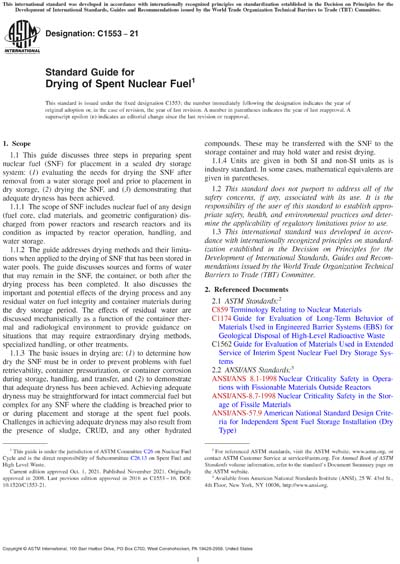Most recent
ASTM C1553-21
Standard Guide for Drying of Spent Nuclear Fuel
1.1This guide discusses three steps in preparing spent nuclear fuel (SNF) for placement in a sealed dry storage system: (1) evaluating the needs for drying the SNF after removal from a water storage pool and prior to placement in dry storage, (2) drying the SNF, and (3) demonstrating that adequate dryness has been achieved.
1.1.1The scope of SNF includes nuclear fuel of any design (fuel core, clad materials, and geometric configuration) discharged from power reactors and research reactors and its condition as impacted by reactor operation, handling, and water storage.
1.1.2The guide addresses drying methods and their limitations when applied to the drying of SNF that has been stored in water pools. The guide discusses sources and forms of water that may remain in the SNF, the container, or both after the drying process has been completed. It also discusses the important and potential effects of the drying process and any residual water on fuel integrity and container materials during the dry storage period. The effects of residual water are discussed mechanistically as a function of the container thermal and radiological environment to provide guidance on situations that may require extraordinary drying methods, specialized handling, or other treatments.
1.1.3The basic issues in drying are: (1) to determine how dry the SNF must be in order to prevent problems with fuel retrievability, container pressurization, or container corrosion during storage, handling, and transfer, and (2) to demonstrate that adequate dryness has been achieved. Achieving adequate dryness may be straightforward for intact commercial fuel but complex for any SNF where the cladding is breached prior to or during placement and storage at the spent fuel pools. Challenges in achieving adequate dryness may also result from the presence of sludge, CRUD, and any other hydrated compounds. These may be transferred with the SNF to the storage container and may hold water and resist drying.
1.1.4Units are given in both SI and non-SI units as is industry standard. In some cases, mathematical equivalents are given in parentheses.
1.2This standard does not purport to address all of the safety concerns, if any, associated with its use. It is the responsibility of the user of this standard to establish appropriate safety, health, and environmental practices and determine the applicability of regulatory limitations prior to use.
1.3This international standard was developed in accordance with internationally recognized principles on standardization established in the Decision on Principles for the Development of International Standards, Guides and Recommendations issued by the World Trade Organization Technical Barriers to Trade (TBT) Committee.
Content Provider
ASTM International [astm]






